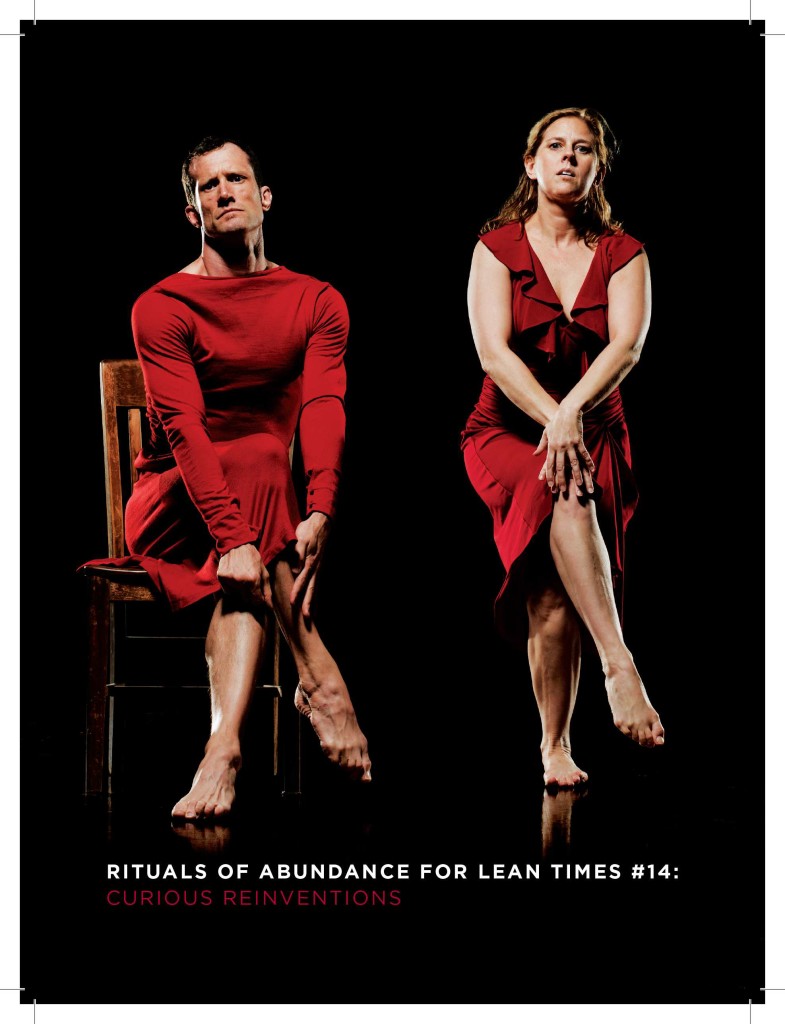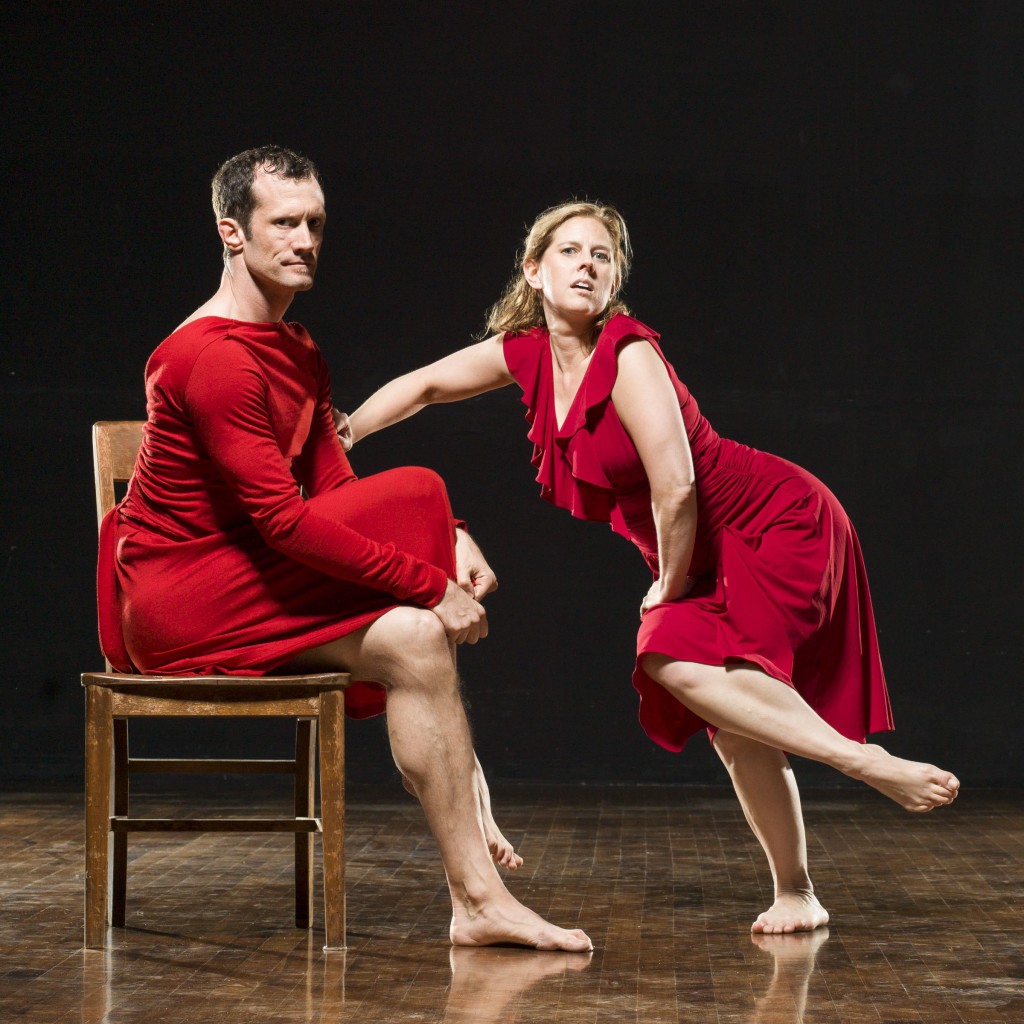Choreographers Margi Cole of The Dance COLEctive and Peter Carpenter of Peter Carpenter Performance Project discuss collaborating on “Rituals of Abundance for Lean Times #14: Curious Reinventions”, a project that explores the concepts of mimicry and imitation.

What first inspired you to collaborate?
Margi Cole: Pete and I go way back, and I have always admired his work as a performer and choreographer. After a very chance conversation about the possibility of me being a performer in his work, it happened, and I had the great pleasure of performing in two of his very recent installments of Rituals of Abundance for Lean Times, the series he is working on. To be blunt, I am totally turned on by working with Pete in the studio, creating movement vocabulary, exploring the use of text and the creative process. As a result of my own experiences, I wanted my dancers to have an opportunity with him too, as I know firsthand how much can be gained from the work. Double bonus: I get to be a co-choreographer and continue to learn as well. It’s an awesome opportunity created by being in the right place at the right time.
Peter Carpenter: Margi and I have known each other as part of Chicago’s dance community for years. In the fall of 2012, she performed in an earlier installment of the Rituals of Abundance for Lean Times series (a series I’ve been working on since 2011), and then last year she invited me to come and do some workshops with her company. Several of her company members are former students of mine (from Columbia College Chicago, where we are both faculty members) so I was excited to work with them. From there we pursued an opportunity via the Department of Cultural Affairs and Special Events for a produced event at the Storefront Theater. That was about a year ago, and we’ve been in the planning stages of this performance ever since.
How did the idea of exploring the concept of mimicry come about?
Cole: Pete led a series of workshops with the dancers that included mimicry and the opportunity to mimic each other. Since they are a close-knit group and have worked together for a long time, they were totally keyed into each other’s idiosyncratic mannerisms and quite willing to make the exploration. This was fun to watch, and we wanted to dig deeper. The idea evolved from there.
Carpenter: Some of the workshops I did with the company were based in an assumption that, in mimicking others during improvised scores, we can expand our own capacity as performers. This led me to think about theoretical applications of mimicry that are floating in theoretical areas such as postcolonial theory, psychoanalysis, queer theory, etc. Particularly in postcolonial theory and queer theory, there’s a notion that the copy can take power over the original. We wondered how our attempts to copy each other could expose assumptions and values that we both held—this is most evident in the dance in terms of the ways gender-coded gestures are performed.

What are the stages of transforming a concept into a performance?
Cole: I am not sure I can identify exactly each stage in the process. It tends to be a bit different for each experience. Generally, I think you have to give yourself permission to take your time but also be accountable to the material. While you can start with solid ideas and some ways to explore those ideas, I think you have to be open to listening to where the material tells you to go—backwards, forwards or in a new direction altogether. You also have to be OK with editing and sometimes letting favorite material go if it does not support the arc of the work.
Carpenter: I think you need to find a balance between rigor and play. At times we gave ourselves permission to be very literal in our application of the concept. At times we developed material that appeared to be irrelevant to the arc of the work. I think the revision process is much more significant than the point of departure, and revision requires the ability to pay attention to the material, even after you’ve been working with it for a while.
How do your choreographic and creative processes differ from one another?
Cole: They say two heads are better than one. In so many ways I think that is true. We have different backgrounds, working styles, strengths and weaknesses. The way he creates, constructs and shapes the material is different than the way I do it. That said, we have somehow been able to find a harmonic creative balance, reaping the benefit of each of our strengths and challenging each other in the process.
Carpenter: I’m not sure if I have enough distance to answer that question accurately, but here’s a try. I might value dissonance a bit more than Margi does. I’ve learned a lot about how she can bring harmony to a composition. We’re both very attached to craft, though I think we value different aspects of craft. And Margi is a great cleaner of material and seems to enjoy it. I hate that stuff!
What does an average day of collaboration look like?
Cole: Sometimes we see each other almost every day of the week. We have been rehearsing on our own as well as in our regular full cast rehearsals so we have been spending a lot of time together in the studio. That said, we spend almost as much time across from each other on our laptops divvying up administrative duties and crossing things off our list so we can ultimately get to a discussion about the work. Sometimes that happens at the computer and sometimes in the studio. We do a lot of what I call “going to the tape.” We have been recording our rehearsals and using Vimeo as a place to observe the work we are doing. This allows us to make notes, watch ourselves in the work and move the process along. There are late-night emails, text messages and, frankly, lots of laughing. It has been good.
Carpenter: We’re both producing this as well as choreographing, so we’re set up with our laptops a lot of days. When we’re in the studio, we’re pretty focused and looking to each other for feedback when the other one takes the lead. Generally we allow one person to lead at a time and have set points where we pass the baton to the other person. We’ve both had a lot of experience collaborating with others, so we found a pretty easy rhythm. We laugh a lot.

Does a collaboration take longer to create than a work produced on your own?
Cole: Sometimes it can take longer, but I think it can be successful if you own the nature of the beast. Collaboration, after all, is the action of working together with someone on something. You have to be willing to be a leader and a follower. Clear, honest and effective communication is key. A mutual respect for each other’s working style and listening help to move things along.
Carpenter: Usually collaborations take a lot longer, but I’ve been impressed with how quickly we’ve moved on this one.
How does collaborating benefit you artistically?
Cole: We have different voices, and this creates the opportunity for those voices/ideas to intersect and collide. It creates an active space for spontaneity, inquiry and dialogue, elements necessary to create and grow as an artist. How lucky are we to be able to allow creativity and learning to work hand in hand every moment.
Carpenter: It’s always good to get a new perspective. I can definitely say that this work speaks pretty specifically to both of our strengths.
Tell us a little about Rituals of Abundance for Lean Times #14: Curious Reinventions…
Cole: It is a sort of formal, “behind the scenes” look at the creation of the work and its participants.
Carpenter: We’re going to be moving the audience all over the space. Audience members will stand in the catwalks, see performances in the lobby and hang out with the cast backstage at one point. It will be an adventure! I think there’s some pretty interesting dancing, some great music by Michael Caskey and interesting text that brings context and complexity to the work.
“Rituals of Abundance for Lean Times #14: Curious Reinventions” will be showing at the DCA Storefront Theater in Chicago May 1st and 2nd.




